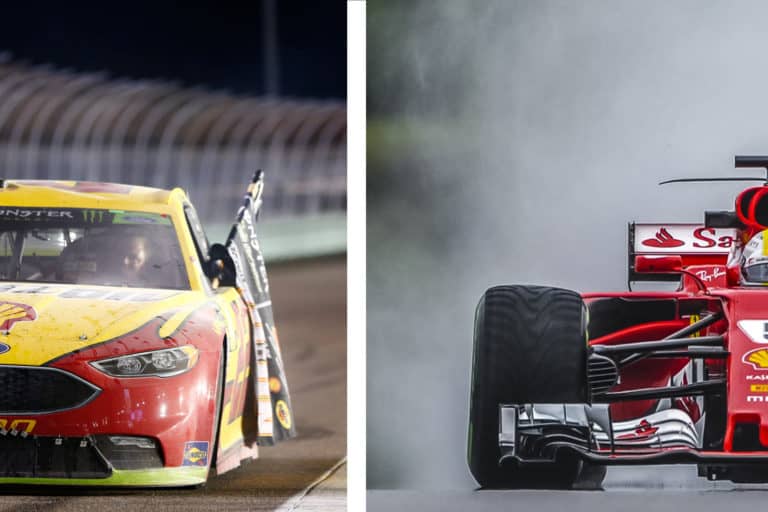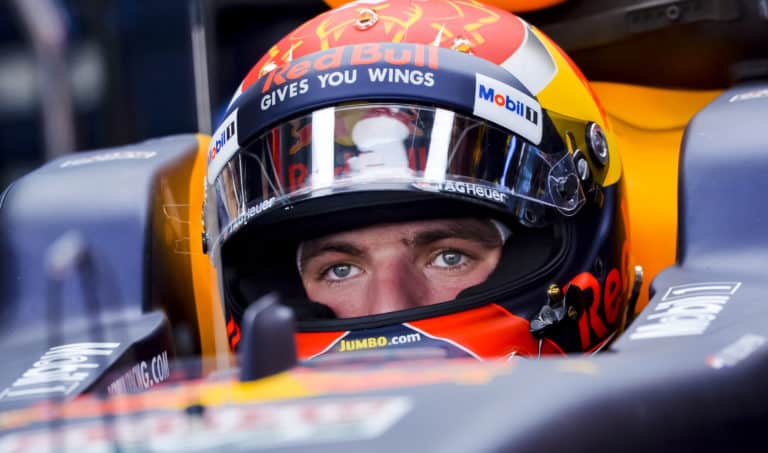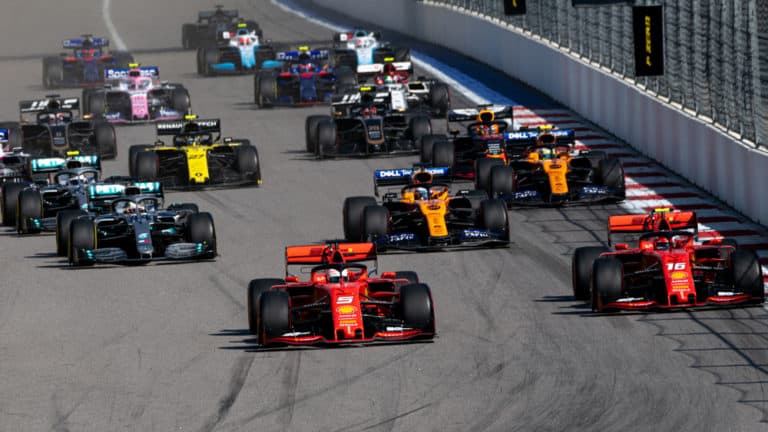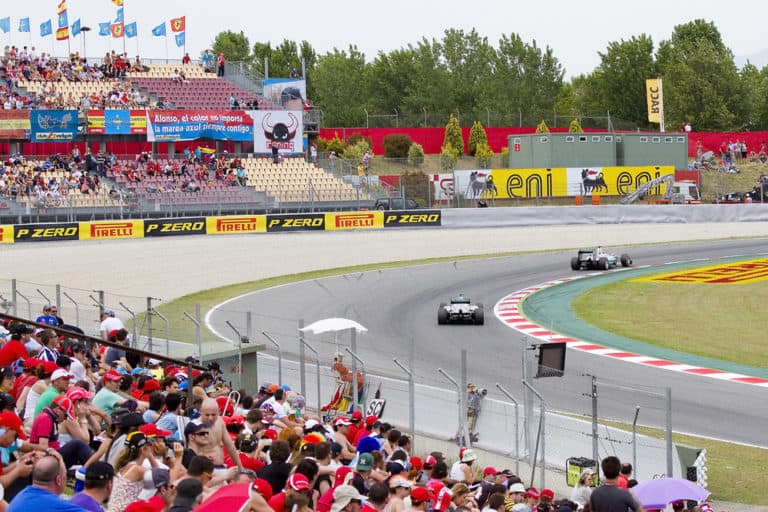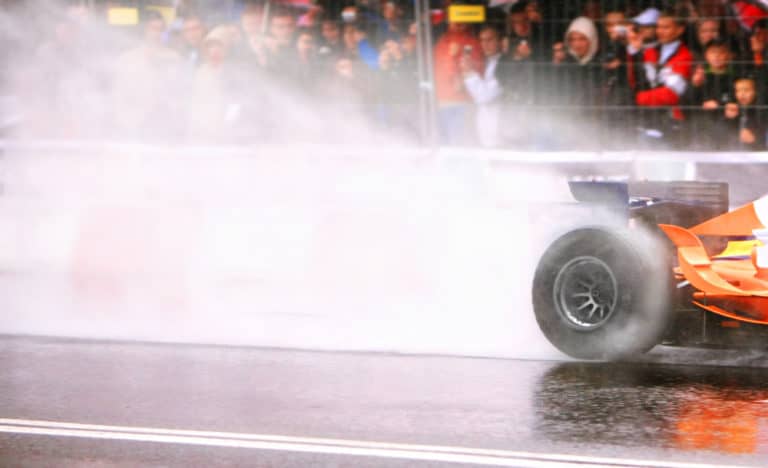Image editorial credit: Edward R / Shutterstock.com
Formula 1 cars are some of the most impressive vehicles in motorsport. F1 is always on the leading edge of technology and development when it comes to their cars. The way these vehicles look is no different. The impressive look of F1 cars has led many to ask the question, “are F1 cars painted or wrapped?”
F1 cars are painted. The paint that is used on F1 cars is specially formulated to fit the requirements of each team and their car. The paint that is used plays a vital role in the overall performance of the car in races, as well as showcasing team colors, emblems, drivers’ names, and racing numbers.
The aesthetics of Formula 1 cars are very important, not only because the cars are meant to look good, but the way the car is finished is important for aerodynamics, airflow, and ultimately performance. The impressive designs on F1 cars may lead you to wonder if they are painted or wrapped? Let’s take a closer look at how F1 cars are finished.
Are F1 Cars Painted Or Wrapped?
The colors, designs, patterns, and logos on Formula 1 cars are very carefully applied, and they make a difference not only to the way the car looks but also to how well the car performs.
An uneven finish on the car means uneven air flow and poor aerodynamics, which are serious problems in F1. The way a car in F1 is finished can mean the difference between first and second place.
However, every F1 car still images to have a look that is both functional and incredible to look at. This leads many to ask the question, are F1 cars painted to achieve their look, or are they wrapped?
The answer to this question is that Formula 1 cars are indeed painted rather than wrapped.
Every F1 car on the grid makes use of a specialized and unique paint job that is painstakingly designed and applied by a team of designers and painters.
The paint department in Formula 1 teams is highly specialized, highly trained, and highly skilled. These artists are able to apply the perfect paint to the F1 cars, as well as apply all details, decals, stickers, and finishes before race day.
The paint that is used for Formula 1 racing cars is not only meant to make the cars look good and separate them from the rest of the grid, but the paint is part of the performance of the vehicle as well.
Formula 1 cars are painted rather than wrapped, and there are entire teams of people that work for each racing team that is tasked with designing and applying the paint before each race.
Why Are F1 Cars Painted And Not Wrapped?
You may be wondering why F1 cars are painted rather than being wrapped, as wrapping takes less time, is cheaper, requires fewer people, and is easier to apply than paint.
The truth of the matter is that there are many reasons why F1 racing teams use paint for their cars rather than wraps, but the chief among these is the fact that the cars are so intricate that wrapping a formula 1 car is far more complicated than painting it.
The parts of a Formula 1 car that are painted are highly specialized components. They are designed to provide the best airflow and aerodynamics possible for the car.
This means that every surface of the car that has a design on it or is printed is usually a very unconventional shape that is simply not conducive to wrapping.
To wrap all of the parts of an F1 car that need to be covered with a design would be even more challenging than painting the car. The surfaces of the F1 car must be absolutely perfect without any imperfections, or the vehicle will not operate at its peak performance.
This means that if a wrap is done even slightly incorrectly, the performance of the vehicle is likely to suffer from it.
The speeds that F1 cars race at are also a factor here. If any debris or small particles such as small stones are kicked up and strike the surface of the vehicle, it causes damage instantly.
If this type of damage is caused to a wrap on an F1 car that is traveling at top speed, the wrap is likely to tear and be far more damaged than if the car were painted.
Other racing cars are able to use vinyl wraps, as they are not subject to the same stresses as Formula 1 vehicles are. Other racing cars are also of a more uniform shape, making it much more realistic to wrap the body of the car.
There are other reasons whyF1 cars are painted rather than wrapped, including the fact that the paint job of the car must be re-done every few races, and this is much easier to achieve with paint rather than with a wrap due to the nature of the F1 car.
Formula 1 vehicles also need to have emblems applied on top of the paint to represent sponsors and to convey other important information such as driver numbers.
These stickers can not be safely applied, removed, and reapplied on a wrap without damaging it, which is another reason to use paint rather than a wrap for F1 cars.
Why Is The Paint On An F1 Car So Important?
While the paint that is used on F1 racing cars looks great and is designed to make the car look impressive and intimidating, the paint has just as much function as it has form.
The paint that is used on these high-performance vehicles is integral to the overall performance of the car during a race. Paint may seem like a trivial thing, and for most other motorsports, it is nothing but aesthetic, but in F1, it is a vital piece of the puzzle that could mean the difference between scoring points or going home empty-handed.
There are several reasons why the paint that is used for F1 cars is so important, but let’s begin with the most obvious reasons:
Weight – the weight of the paint that is applied to the car is of utmost importance. F1 cars are built to very fine tolerances, and keeping the weight of the car down is vital.
If the paint weighs too much, it may slow the car down by a few hundredths of a second, which in F1 may as well be minutes.
Having a light coat of paint keeps the overall weight of the car down. F1 cars have on average only about 1.5kg (3.3lb) of paint applied to them, in contrast to the 25 – 30kg (55 – 66lb) of paint that is applied to commercial cars.
Aerodynamics – If the paint on the F1 car is not applied correctly, and if it is applied in layers that are too thick, it can negatively affect the aerodynamics of the car as it moves through the air.
Aerodynamics is as important in F1 as the power unit or the handling of the car and can mean the difference between winning and losing.
Correctly applying the paint will ensure that all of the incredible hard work that the engineers have put into designing the car to make it as aerodynamic as possible does not go to waste.
Airflow – there is a big difference between aerodynamics and airflow. The airflow determines how the air moves over the car, not how the car moves through the air. Airflow is an important part of the downforce that acts upon the car while moving, and so it is a vital aspect of handling and traction.
If the paint that is applied to a Formula 1 car is not applied correctly or is not applied smoothly, it will drastically affect the airflow of the car.
If the airflow is ruined, the car will be at a severe disadvantage on the track, and it may cost races, which is not acceptable.
Smoothing Out The Body – this is a little-known fact, but the paint crew that is in charge of painting and finishing F1 cars are also in charge of making sure that the body and components of the car are as smooth and as smoothly connected as possible.
F1 cars are made from carbon fiber materials and metal. These two materials must be joined together in places, which is very tricky to do, and often leaves gaps or small bumps, protrusions, or imperfections on the surface of the car.
Using fillers and paints, the painting crew must correct these imperfections and fill in the gaps to make the car as perfect as possible.
Paint applied in the right way in the right location on the car can significantly improve the lines and smoothness of the body of the car, which improves overall performance.
Overall, the paint is a vital aspect of any F1 car, and every team takes their paintwork very seriously. The paint can make or break an F1 car and means the difference between a successful Grand Prix season and a dismal failure.
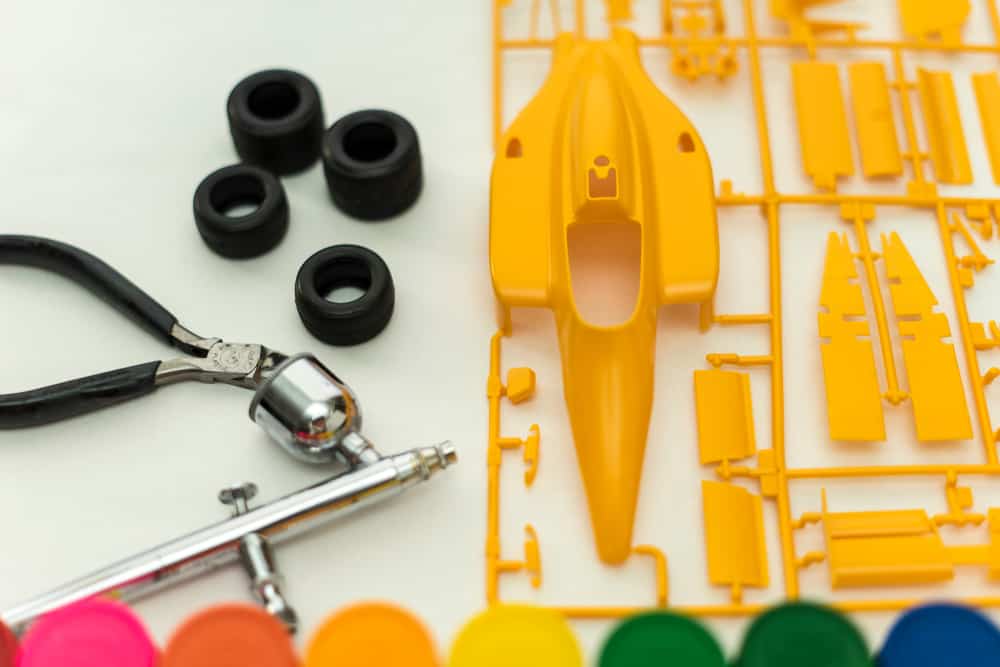
How Is Paint Applied To Formula 1 Cars?
The paint that is used for F1 cars is very important, and this means that the process of applying it is just as crucial.
However, most F1 teams are particularly secretive about their paintwork, as it is an aspect of constructing their car that can be easily copied by rival teams if the information becomes public information.
That being said, there are a few facts that we can glean about the application of F1 car paint from promotional materials and information provided by teams such as McClaren in the past.
Formula 1 teams either use specialized paint booths to apply the paint to each component of the cars’ body, or teams of specialized painters use a combination of tools such as airbrushes to apply the paint by hand.
There are some aspects of the paintwork on F1 cars that are always done by hand, and there are some bigger areas that can be placed in a spray booth for painting.
For example, it is public knowledge that the Mercedes Petronas F1 racing team use artists to apply their Mercedes emblems to the racing car by hand using airbrushes and that the McClaren team uses an automated paint booth for the majority of their paintwork.
The paint on F1 cars is usually applied in three layers, with one or two coats of primer layer down beneath it. Lacquer is used to seal the paint and to provide it with the finish that the team desires.
In the past, F1 cars were all finished with high-gloss lacquers, but currently, there are several F1 teams that have chosen to use a matte finish for their car, as apparently matte is lighter than other types of paint. This tactic is used by teams such as Scuderia Ferrari and Redbull Racing.
Are Wraps Ever Used For F1 Cars?
As it currently stands, there are no F1 teams that opt for using wraps rather than paint for their racing car, but there are some aspects of the aesthetics of F1 cars that are not painted on.
The logos, emblems, slogans, and sponsorship brandings that are seen on F1 racing cars are not painted on, but these are rather a series of carefully placed stickers that may be considered to be a type of vehicle wrap.
Some cars, such as the Redbull Racing Formula 1 cars, have large areas of the vehicle covered with these stickers, such as the large Redbull logo in the sharkfin of the modern cars.
These stickers are not strictly wraps, but they are hand-placed decals that are very important for the car.
The placements of the stickers, their weight, and their size are all vitally important for airflow and the aerodynamics of the racing car, and so the placement and design of these stickers are never random and are always by careful design.
Even the thickness of the stickers is taken into account, and plenty of areas on the car will have no stickers applied on them because it will compromise the performance of the car.
Stickers that are placed on the rear wing have been proven to significantly reduce performance, so any emblems or branding on this area is always painted on or built into the wing, but most other logos seen on F1 cars are stickers.
Wraps are lighter than paint, so there may be a possibility of seeing this type of finish applied to F1 cars in the future, but for now, wraps are simply not tough enough for use by these incredible machines.
Conclusion
The final finish on modern Formula 1 cars is always paintwork, not wrapping. Paint is best for F1 cars for many reasons, including durability.
Not only do F1 teams only use paint for their cars, but they use the paint to improve the performance of the car on the race track.
The paint that is used on F1 cars plays a vital role in the aerodynamics, airflow, and final bodywork of the car. All of this is critical for maximum performance, traction, and handling for the racing car.
Without the perfect paint job, any F1 car will be at a disadvantage on the track. The slightest imperfection will slow the car down enough for it to be difficult for any driver to effectively compete in the Grand Prix.
The right paint that is applied well makes all the difference in the high-performance world of F1. It can make the difference between a championship-worthy Grand Prix season or a complete failure.
The next time you watch a race, take notice of the careful and precise paintwork on the cars, and remember all the hard work, patience, engineering, and design that went into the finished product!

